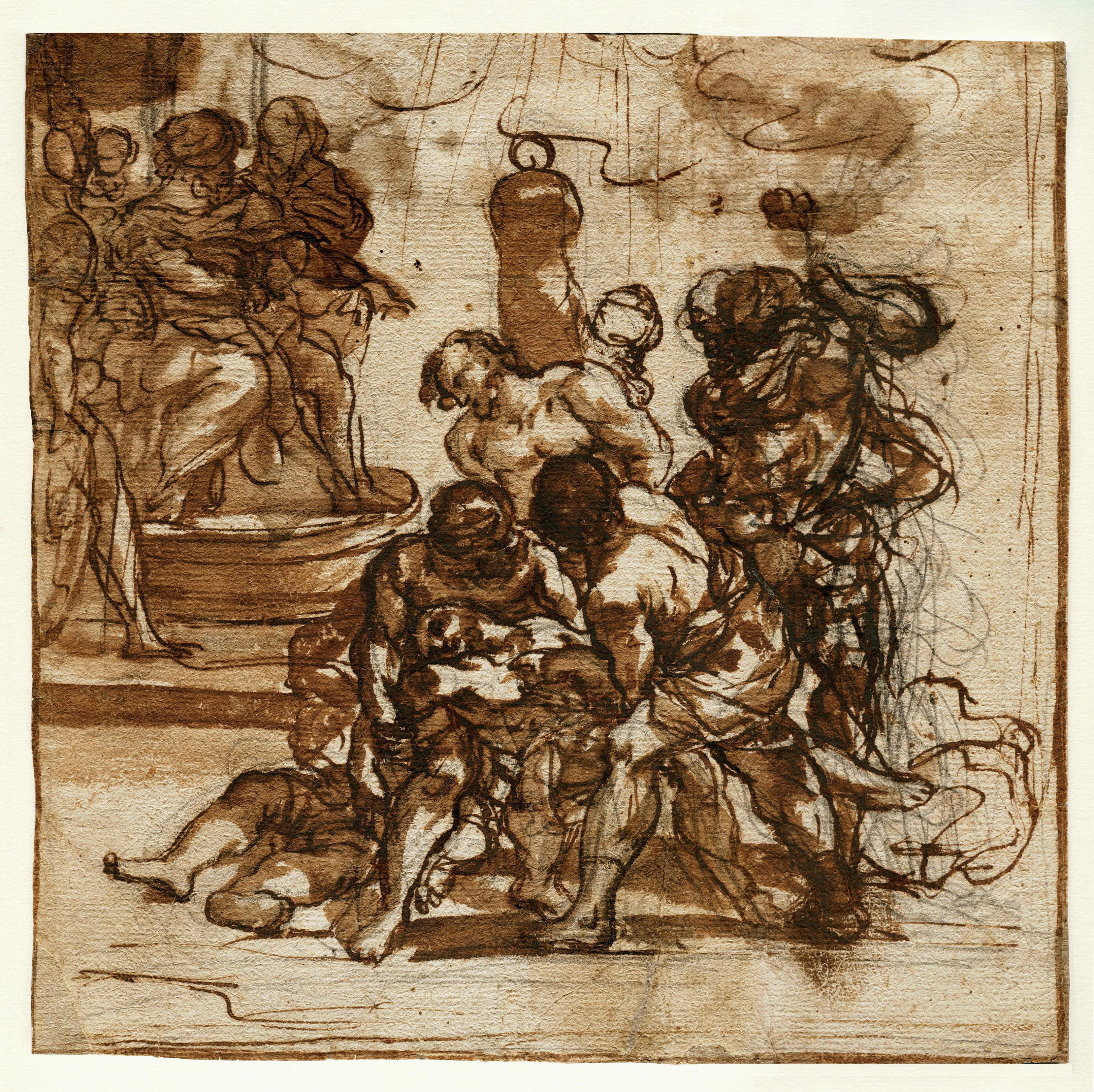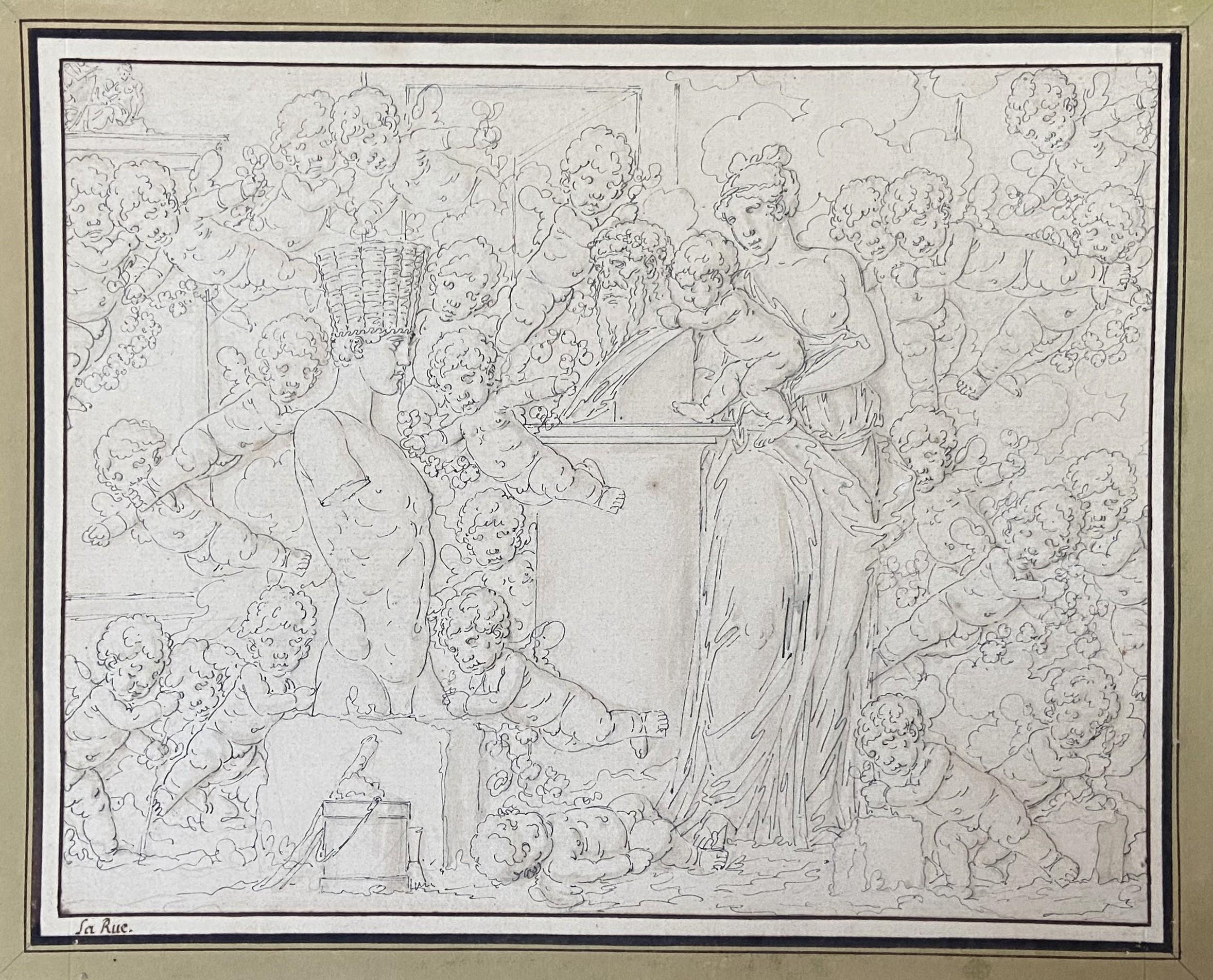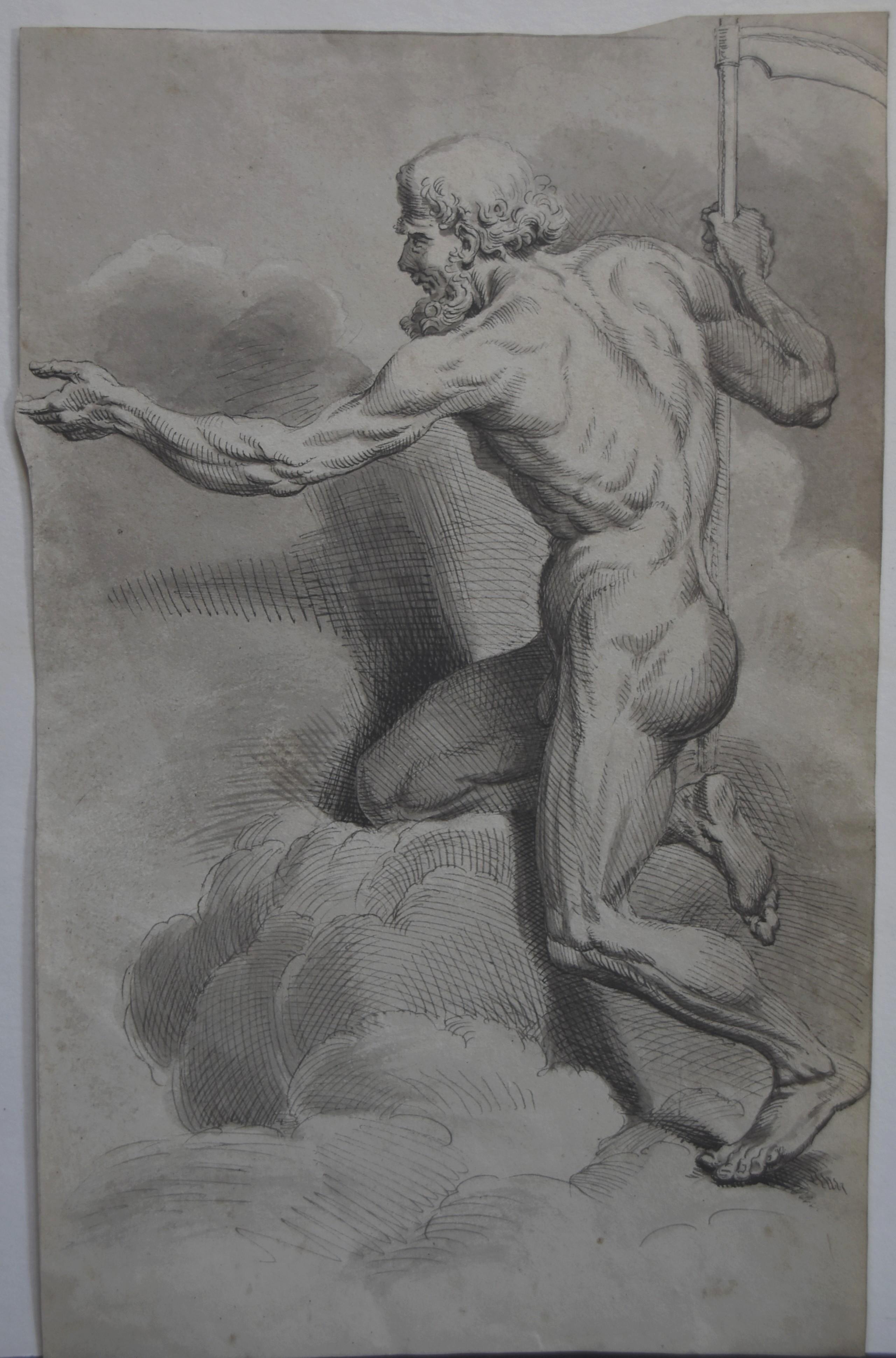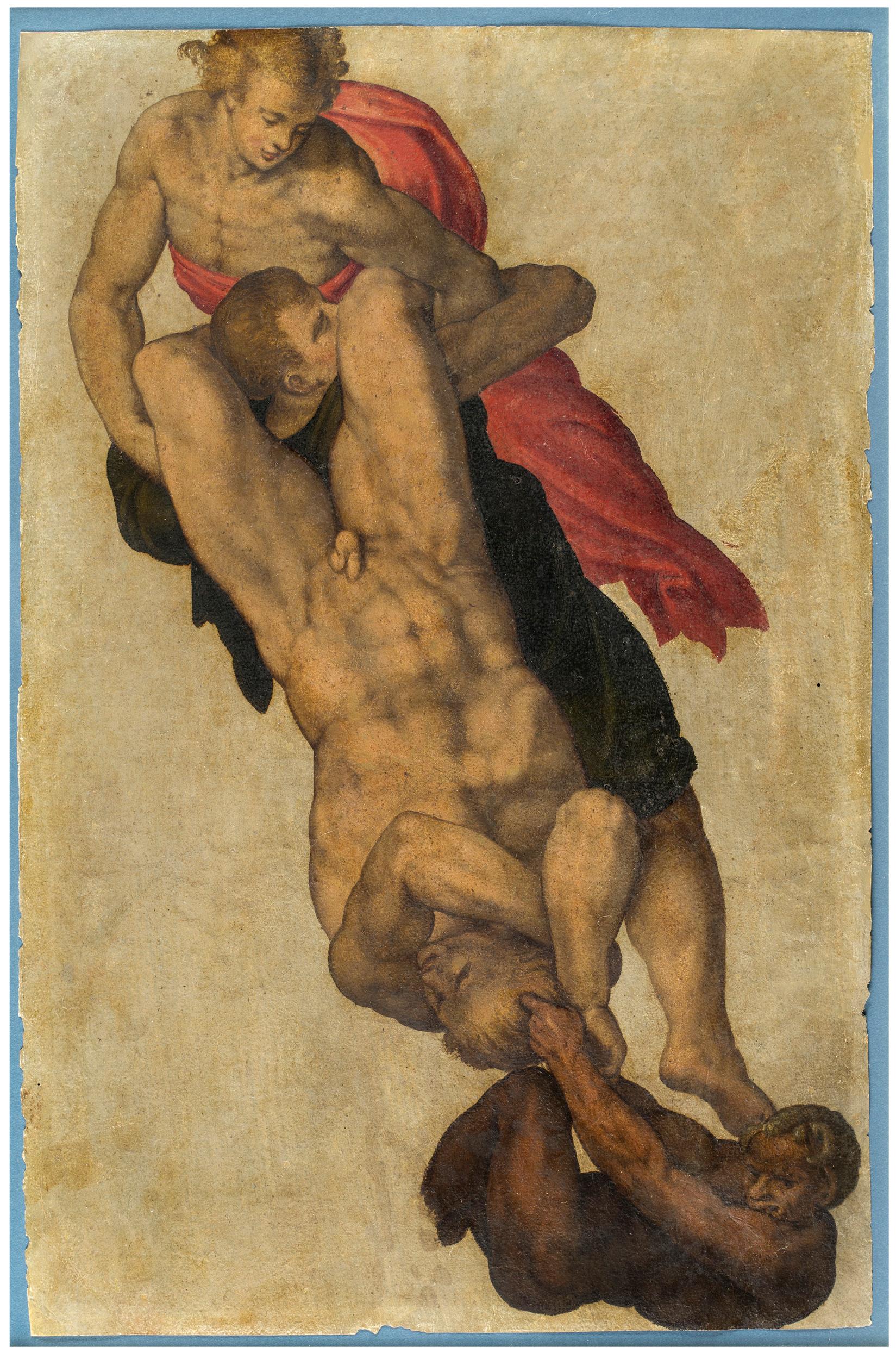Items Similar to Study in the Antique Style, a neoclassical drawing by Augustin Pajou
Want more images or videos?
Request additional images or videos from the seller
1 of 7
Augustin PajouStudy in the Antique Style, a neoclassical drawing by Augustin Pajou Circa 1752
Circa 1752
About the Item
In this lively and fresh drawing, probably taken from one of the artist's notebooks, Pajou presents us with a composition freely inspired by antiquity, as a souvenir of a visit to the Villa Borghese. This evocation of the artist's Roman sojourn is made even more moving by a self-portrait sketch of the artist on the back of the sheet...
1. Augustin Pajou in Rome, a great sculptor in training
The son of a journeyman woodcarver, Augustin Pajou entered the Royal Academy school at an early age, where he trained under Jean-Baptiste II Lemoyne (1704-1778). Laureat of the grand sculpture prize in 1748 (at the age of eighteen), he joined the Royal School for protected pupils, received an annuity from the King from 1751 onwards, and stayed at the Royal Academy in Rome from 1752 to 1756. These years in Rome were to have a decisive influence as they allowed him to study not only his art but also to receive a classical education which he had not had access to in his youth.
Back in Paris, he received his license from the Royal Academy in 1759 and was finally accepted the following year. An extremely prolific and diverse artist, he was a sculptor, a decorator and a "bustier" creating terracotta or marble effigies of the great figures of his time in.
Pajou's graphic work is also very rich. As Louis-Antoine Prat writes in "Le Dessin Français au XVIIIe siècle": "Pajou displays a particularly varied body of work, showing flexibility in his approach to antiquity and the masters [...]. He is certainly, among the draughtsmen-sculptors of the century, and one who was able to express himself in the greatest number of registers. »
2. A notebook sheet drawn on the motif
Pajou drew a lot during his stay in Rome. He produced very advanced compositions in red chalk, probably intended to be sent to the Marquis de Marigny as a testimony of his progress at the Academy. In his notebooks that have now been dismantled, he uses a more personal style, employing various techniques: black stone, pen, grey or brown wash. Pajou interprets both ancient art and scenes from everyday Roman life with an "astonishing elliptical speed". In this respect, our drawing can be compared, in terms of workmanship and size, to the "Cardinal Grand Pénitencier" now in the Metropolitan Museum of Art in New York (USA) .
The autograph annotation 'villa Borgaise plus de moy que de l’ antique' gives us information about the place in which our drawing was conceived, although it is likely, as the artist indicates, that the antique bas-relief from which he drew his inspiration was heavily modified by his imagination. We have not been able to identify this bas-relief, as the Villa Borghese, built at the beginning of the seventeenth century in the middle of a large park on the Pincio hill in Rome, was redecorated from 1770 for Marcantonio IV Borghese.
A woman wrapped in a long tunic sits on the edge of a bed with a zoomorphic foot that evokes a lion's paw. She is pointing to a large urn being held up by a bearded old man crouching at her knees. Various characters are evoked in the background and complete the scene. In a surprising and unanatomical manner, the artist forcefully depicts the main character’s right breast outside her tunic, which perhaps justifies his comment!
3. A self-portrait of Pajou?
A surprise awaits us on the back of this sheet: the portrait of a man, very lightly sketched in graphite, front view, wearing a tricorne hat. The inclusion of various very different elements (a scene in wash and a portrait in graphite for which the same sheet is used in a different direction) is typical of an artist's notebook.
The features of this portrait are reminiscent of those of Augustin Pajou in a portrait of him by Adélaïde Labille-Guillard and this drawing could therefore be a self-portrait of the artist.
Main bibliographic reference :
Louis-Antoine Prat French Drawing in the 18th Century - Paris 2017
- Creator:Augustin Pajou (1730 - 1809)
- Creation Year:Circa 1752
- Dimensions:Height: 5.52 in (14 cm)Width: 7.68 in (19.5 cm)
- Medium:
- Movement & Style:
- Period:1750-1759
- Condition:Ink and wash on paper 14x19.5 cm (32.5 x 36.5 cm framed) Annotated in ink "villa Borgaise plus de moy que de l'antique" and "Pajou" on the reverse Self-portrait of the artist (?) wearing a tricorn on the reverse Louis XVI period giltwood frame.
- Gallery Location:PARIS, FR
- Reference Number:1stDibs: LU156828245692
About the Seller
5.0
Vetted Seller
These experienced sellers undergo a comprehensive evaluation by our team of in-house experts.
Established in 2020
1stDibs seller since 2021
8 sales on 1stDibs
Typical response time: 2 hours
- ShippingRetrieving quote...Ships From: PARIS, France
- Return PolicyA return for this item may be initiated within 3 days of delivery.
More From This SellerView All
- Three drawings by François Boucher in a mounting by Jean-Baptiste GlomyBy François BoucherLocated in PARIS, FRWe would like to thank Juliette Parmentier-Courreau of the Custodia Foundation for her welcome and support during the consultation of Glomy’s Journal des Ouvrages. This spectacularly large "feuille de desseins ajustés" commissioned by François Boucher from Jean-Baptiste Glomy is emblematic of the painter's art and mastery of rocaille. It is also fully representative of the taste of this period in the field of decorative arts. The largest of these three drawings, placed at the bottom of the composition, is particularly interesting: dating from around 1756, it constitutes a modello (apparently unpublished) for the frontispiece of the "Catalogue des tableaux de Monsieur de Julienne"), preserved in the Morgan Library in New York. 1. François Boucher, the master of French rocaille The extraordinary career of Francois Boucher was unmatched by his contemporaries in versatility, consistency and output. For many, particularly the writers and collectors who led the revival of interest in the French rococo during the last century, his sensuous beauties and plump cupids represent the French eighteenth century at its most typical. His facility with the brush, even when betraying the occasional superficiality of his art, enabled him to master every aspect of painting – history and mythology, portraiture, landscape, ordinary life and, as part of larger compositions, even still life. He had been trained as an engraver, and the skills of a draftsman, which he imbued in the studio of Jean-Francois Cars (1661 – 1738), stood him in good stead throughout his career; his delightful drawings are one of the most sought-after aspects of his oeuvre. As a student of Francois Lemoyne (1688 - 1737), he mastered the art of composition. The four years he spent in Italy, from 1727-1731, educated him in the works of the masters, classics and history, that his modest upbringing had denied him. On his return to Paris in 1734, he gained full membership of the Royal Academy of Painting and Sculpture with his splendid Rinaldo and Armida (Paris, Musée du Louvre). Although, throughout his career, he occasionally painted subjects taken from the Bible, and would always have considered himself first as a history painter, his own repertoire of heroines, seductresses, flirtatious peasant girls and erotic beauties was better suited to a lighter, more decorative subject matter. His mastery of technique and composition enabled him to move from large scale tapestry...Category
1750s Old Masters Figurative Drawings and Watercolors
MaterialsChalk, Ink
- Study of a Fate at mid-body, a red chalk attributed to Giovanni da San GiovanniLocated in PARIS, FRThis spectacular red chalk drawing depicts an elderly woman, her eyes bulging, her hand stretched out towards the sky. This disturbing character, who seems close to dementia, and the elongation of her arm with its Mannerist overtones, plunge us into the Florentine artistic milieu of the first half of the 17th century. The proximity of this drawing to some characters in the fresco in the Pitti Palace representing The Muses, Poets and Philosophers chased from Parnassus, the last masterpiece of Giovanni da San Giovanni, leads us to propose an attribution to this artist and a dating of around 1635-1636. 1. Giovanni da San Giovanni, the painter of contradiction We take here the title of the monography dedicated to the artist by Anna Banti in 1977, which remains the reference book for this artist. The son of a notary, Giovanni Mannozzi, known as Giovanni da San Giovanni, abandoned his studies to go to Florence at the age of sixteen, where he entered the studio of Matteo Rosselli (1578 - 1650) around 1609 and enrolled in the Academy of Drawing Arts in 1612. Around 1615 he produced his first known works, mainly frescoes for the city's tabernacles. He became famous in Florence for his originality, combining an obsessive application to the study of drawing and the reading of poetry and history with a disheveled appearance. Between 1619 and 1620 he decorated the facade of the Antella Palace in Piazza Santa Croce, a decoration that still partly survives today. The death of Cosimo II in 1621 put an end to the Florentine building activity and Giovanni da San Giovanni left for Rome to find other sponsors with the painter Francesco Furini...Category
17th Century Old Masters Nude Drawings and Watercolors
MaterialsChalk
- Astraea, a study for the Golden Age fresco at Dampierre by IngresBy Jean-Auguste-Dominique IngresLocated in PARIS, FRThis beautiful drawing, of great technical virtuosity, is one of the many studies made by Ingres for Astraea, one of the key characters in the Golden Age fresco he painted between 18...Category
1840s Old Masters Nude Drawings and Watercolors
MaterialsInk, Pen, Pencil, Carbon Pencil
- The Martyrdom of Saint Bartholomew, a preparatory drawing by Alessandro CasolaniLocated in PARIS, FRThis powerful pen and brown ink wash drawing is a study for an altarpiece depicting The Martyrdom of Saint Bartholomew. Signed and dated 1604, it was painted at the end of his life b...Category
Early 1600s Old Masters Figurative Drawings and Watercolors
MaterialsInk, Pen
- Modello for the Virgin of the Rosary, a drawing by Francesco Vanni (1563 - 1610)Located in PARIS, FRFrancesco Vanni is one of the last representatives of the long Sienese pictorial tradition. In this masterly composition in pen and ink wash, he presents the Virgin of the Rosary, holding the Child Jesus on her lap, surrounded on her right by Saint Dominic and on her left by Saint Catherine of Siena. The presence of these two emblematic saints of the Dominican order is a reminder of the devotion of this order to the Rosary. 1. Francesco Vanni, a Sienese painter of the Counter-Reformation Francesco Vanni was the most important Sienese painter of the late sixteenth century and a key Italian Counter-Reformation painter. He developed a very specific style, inspired not by Florentine models but rather by the Roman, Bolognese and Marche schools, and in particular by the work of his contemporary Federico Barocci (Urbino 1535 - 1612), despite the two artists never meeting. Francesco Vanni was born in Siena around 1563-1564. His father died in 1567 and his mother remarried Arcangelo Salimbeni (1536 - 1579), then one of Siena’s leading painters. His half-brother Ventura Salembini (1568 - 1613) also became a well-known painter. He continued his apprenticeship in Bologna and Rome, where he joined the painter Giovanni de Vecchi’s (1536 - 1614) studio, where he was greatly influenced, like other Tuscan painters of the time, by the art of Federico Barocci. He devoted himself mainly to religious painting, following the canons of the Counter-Reformation. Travelling between Siena, Rome, Bologna and Parma, in 1604, he settled in Siena, where he ended his life. Vanni was also an important member of the Confraternity of the Sacro Chiodo, renowned for its demanding religious practices. His legacy also includes some important engraved work. 2. Description of the artwork The Virgin is depicted enthroned in majesty, slightly taller than the other figures that she dominates from her pedestal. Her wide robe with marked folds evokes Renaissance statuary. She is crowned by two angels in the sky. These two angels are a reminder of the custom of adding angels to crown 13th century icons which was frequent at Vanni’s time. The Child Jesus is standing on the Virgin’s right knee. With her left hand she holds out a rosary to Catherine of Siena, identifiable by a branch of lily in her hand. In a symmetrical gesture, the Child Jesus also holds out a rosary to St Dominic. Two of St Dominic’s attributes are to be found at the foot of the Virgin: a book and a branch of lilies. Vanni gives particularly delicate treatment to St. Dominic's long and slender hands. The two outstretched rosaries form the link between the heavenly register of the Virgin and the Child Jesus and the earthly register of the two Dominicans who are not crowned with a halo. This and the fact they are followed by a large crowd, indicates that they are both represented as part of the multitude of the living called to pray to the Rosary. According to the classical iconographic tradition, it would be plausible to consider that the figure looking at the viewer on the extreme left of the drawing could be a self-portrait of the painter. Francesco Vanni's face is known to us from a self-portrait kept in the Pinacoteca Nazionale in Siena. The squaring of the drawing suggests that it was used for a larger-scale altarpiece, probably for a church dedicated to St Dominic or for a Dominican convent. As of today, we have not identified the painting for which this drawing served as a preparatory modello. The Madonna of the Rosary in the Cathedral of Pitigliano (painted by Francesco Vanni in 1609) differs quite significantly from our drawing by the addition of Pope Pius V, and the inclusion of St. Dominic and St. Catherine in the celestial register. We believe that our drawing predates this painting because of its more symmetrical composition, and less Baroque influence. The presence of Saint Catherine of Siena, particularly venerated in his native town, to which Francesco Vanni returned frequently from 1590 onwards, leads us to propose a date of around 1590 - 1600 for this drawing. 3. The Rosary and the Dominican Order In order to clarify the iconographic meaning of this artwork, it is worth recalling the role of Saint Dominic in the spread of the Rosary prayer. Dominic Nuñez de Guzman was born around 1170 in Caleruega (near Burgos) in Spain and died in 1221 in Bologna, Italy. He was the founder of the order of friar preachers, commonly known as the Dominicans. He was canonised by the Church in 1234 and has since been celebrated under the name of Saint Dominic. After three days of prayer in the forest of Bouconne, near Toulouse, Dominic is said to have received the Rosary as a means of converting the Cathar population. The Dominicans subsequently made a special effort to promote this form of meditative prayer. Pope Pius V, a Dominican, included the feast of the Rosary (on October 7th) in the liturgical calendar in 1571. Rosary prayer has evolved over the centuries and traditionally consists of the recitation of three rosaries (four since St John Paul II). Each rosary consists of five tens of "Hail Mary...Category
16th Century Old Masters Figurative Drawings and Watercolors
MaterialsPen, Ink
- Study for a Frontispiece, a baroque drawing by Giovanni Antonio PellegriniBy Giovanni Antonio PellegriniLocated in PARIS, FRThis masterly frontispiece study, executed with a very sure hand, testifies to the survival of the great Baroque taste in 18th century Venice. It could be one of the very last works by Giovanni Antonio Pellegrini: the few lines that cross the papal arms evoke those of Benedict XIV, who became pope in 1740, one year before the artist's death. 1. Giovanni Antonio Pellegrini and the European influence of Venetian history painting in the 18th century Giovanni Antonio Pellegrini was born in Venice in 1675 and trained in the studio of the Milanese painter Paolo Pagani (1655 - 1716). Pagani, who had been living in Venice since 1667, took him to Moravia and Vienna from 1690 to 1696. After a stay in Rome from 1699 to 1701, Pellegrini married Angiola Carriera in 1704, the sister of the great pastelist Rosalba Carriera. From 1708 onwards, Pellegrini left Venice and began an extensive tour of Europe: he worked in England between 1708 and 1713, where he met great success, particularly at Kimbolton Castle and Castle Howard. He then worked in Germany and the Netherlands, then in Bohemia and Austria, before returning briefly to England in 1719. In 1720 he was in Paris where he decorated the ceilings of the Royal Bank for John Law...Category
1740s Old Masters Figurative Drawings and Watercolors
MaterialsInk
You May Also Like
- The Martyrdom of the Santi Quattro CoronatiLocated in New York, NYProvenance: Private Collection, UK After initial training under Justus Suttermans and Vincenzo Dandini, in 1673 Anton Domenico Gabbiani embar...Category
17th Century Old Masters Figurative Drawings and Watercolors
MaterialsPaper, Chalk, Ink, Pen
- Louis-Félix de La Rue (1730-1777) A Mythological scene, drawingBy Louis-Félix DelarueLocated in Paris, FRLouis-Félix de La Rue (1730-1777) A biblical or mythological episode Signed and dated lower right (under the mount, see photos of the drawing out of frame) ...Category
1770s Old Masters Figurative Drawings and Watercolors
MaterialsInk
- Louis-Félix de La Rue (1730-1777) A Mythological scene, drawingBy Louis-Félix DelarueLocated in Paris, FRLouis-Félix de La Rue (1730-1777) A Mythological scene Pen and black ink on paper Bears an old inscription with the name of the artist on the lower left bo...Category
1770s Old Masters Figurative Drawings and Watercolors
MaterialsInk
- French Neo classical school, Allegory of Time, original drawingLocated in Paris, FRNeo classical school, France, end of the 18th Century Allegory of Time, Pen and black ink on paper, gray ink wash 30.5 x 19 cm irregularly shaped In g...Category
1790s Old Masters Nude Drawings and Watercolors
MaterialsIndia Ink
- Study after Michelangelo’s “The Last Judgment”By Michelangelo BuonarrotiLocated in New York, NYItalian School, 16th Century Provenance: Private Collection, New York This intriguing drawing is a study by an anonymous 16th-century Italian artist after a vignette in Michelangelo’s fresco of The Last Judgement in the Sistine Chapel. The altar wall of the Sistine Chapel was already richly decorated when Pope Clement VII commissioned Michelangelo to paint his Last Judgment...Category
16th Century Old Masters Figurative Drawings and Watercolors
MaterialsPaper, Gouache
- Sleeping Boy - Drawing by Giovanni Fontana - 16th CenturyLocated in Roma, ITSleeping Boy is an original modern artwork realized in the 16th century by Giovanni Fontana. Ivory colored sheet attached on an ivory colored cardboard (...Category
16th Century Old Masters Figurative Drawings and Watercolors
MaterialsPaper, Pencil
Recently Viewed
View AllMore Ways To Browse
Antique 3a
A Work In Progress
18th Century Paris
Large Neoclassical Art
French Neoclassical Art
Antique French Drawings
Antique Life Drawing
Antique Old School
French Portrait Of A Man Drawing
Antique Rome Art
French 18th Century Drawing
Old Roman Style
Portrait Train Master
King Size Antique Bed
Antique King Size Beds
Antique King Size Bed
Antique King Size Bed Beds
Antique Bed King Size





